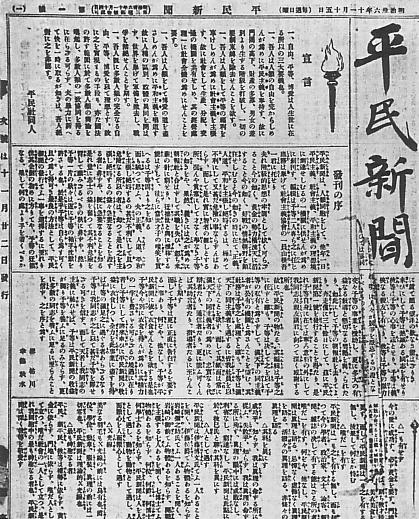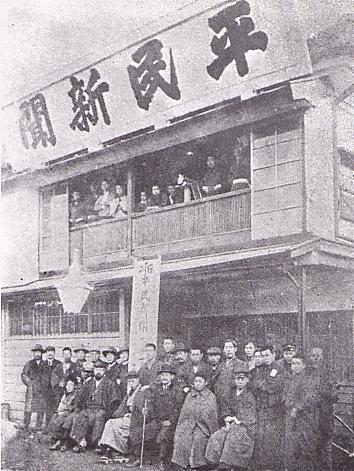Heimin Shinbun on:
[Wikipedia]
[Google]
[Amazon]

 (also spelled ''Heimin Shimbun'') was a
(also spelled ''Heimin Shimbun'') was a
socialist
Socialism is a left-wing economic philosophy and movement encompassing a range of economic systems characterized by the dominance of social ownership of the means of production as opposed to private ownership. As a term, it describes the e ...
and anti-war
An anti-war movement (also ''antiwar'') is a social movement, usually in opposition to a particular nation's decision to start or carry on an armed conflict, unconditional of a maybe-existing just cause. The term anti-war can also refer to pa ...
daily newspaper established in Japan in November 1903, as the newspaper of the Heimin-sha group. It was founded by Kōtoku Shūsui
, better known by the pen name , was a Japanese socialist and anarchist who played a leading role in introducing anarchism to Japan in the early 20th century. Historian John Crump described him as "the most famous socialist in Japan".
He wa ...
and Sakai Toshihiko
was a Japanese socialist, writer, and historian. He is also known by the pen name . He is also known for his translation with Shūsui Kōtoku.
Biography
Sakai was born as the third son to a samurai class family in what is now Miyako, Fukuoka. ...
, as a pacifist
Pacifism is the opposition or resistance to war, militarism (including conscription and mandatory military service) or violence. Pacifists generally reject theories of Just War. The word ''pacifism'' was coined by the French peace campaign ...
response to the approaching Russo-Japanese War
The Russo-Japanese War ( ja, 日露戦争, Nichiro sensō, Japanese-Russian War; russian: Ру́сско-япóнская войнá, Rússko-yapónskaya voyná) was fought between the Empire of Japan and the Russian Empire during 1904 and 1 ...
. When the newspaper that Kōtoku and fellow socialist Sanshirō Ishikawa had worked for, ''Yorozu Chūhō'', endorsed the war, they resigned in protest to form the group.
Kōtoku Shūsui also served as one of the paper's editors. By the beginning of 1904, it was Tokyo
Tokyo (; ja, 東京, , ), officially the Tokyo Metropolis ( ja, 東京都, label=none, ), is the capital and largest city of Japan. Formerly known as Edo, its metropolitan area () is the most populous in the world, with an estimated 37.468 ...
's leading publication advocating socialism. Eighty-two people eventually expressed their allegiance to socialism in this publication. Multiple issues of the newspaper were banned by the Meiji government because they were deemed politically offensive, and editors were arrested, fined, and jailed. The paper ceased publication in 1905. The last issue, published in red, was printed on 18 January 1905. Kōtoku was imprisoned for five months starting in February 1905 due to his participation in the newspaper.
In January 1907, five socialists, including Kōtoku, Sakai, and Sanshirō, renewed the publication, but it was to fold again in April 1907, after a split between advocates of parliamentary reform and advocates of direct action
Direct action originated as a political activist term for economic and political acts in which the actors use their power (e.g. economic or physical) to directly reach certain goals of interest, in contrast to those actions that appeal to oth ...
. It was replaced by two newspapers, one for each faction, including the direct-actionist ''Ōsaka Heimin Shinbun'' which was published bi-monthly from June 1907 until May 1908 (renamed in November 1907 to ''Nihon Heimin Shinbun'').
Two anarchist
Anarchism is a political philosophy and movement that is skeptical of all justifications for authority and seeks to abolish the institutions it claims maintain unnecessary coercion and hierarchy, typically including, though not neces ...
contributors to the initial newspaper, Uchiyama Gudō
was a Sōtō Zen Buddhist priest and anarcho-socialist activist executed in the High Treason Incident. He was one of few Buddhist leaders who spoke out against the Meiji government in its imperialist projects. Gudō was an outspoken advocate f ...
and Kōtoku Shusui, were later convicted and executed in the 1911 High Treason Incident
The , also known as the , was a socialist- anarchist plot to assassinate the Japanese Emperor Meiji in 1910, leading to a mass arrest of leftists, and the execution of 12 alleged conspirators in 1911.
Investigation
On 20 May 1910, the police se ...
.
In October 1914, the anarchists Ōsugi Sakae and Arahata Kanson attempted to revive ''Heimin Shinbun''. Most issues of this version of the paper were banned by the government, and it was discontinued in March 1915.
After the Second World War, the Japanese Anarchist Federation revived the newspaper in June 1946, but the group collapsed in 1950.
See also
* '' Shinkigen Monthly'' *Japanese dissidence in 20th-century Imperial Japan
Political dissidence in the Empire of Japan covers individual Japanese dissidents against the policies of the Empire of Japan.
Dissidence in the Meiji and Taishō eras High Treason Incident
Shūsui Kōtoku, a Japanese anarchist, was critical ...
* Anarchism in Japan
Anarchism in Japan began to emerge in the late 19th and early 20th centuries, as Western anarchist literature began to be translated into Japanese. It existed throughout the 20th century in various forms, despite repression by the state that becam ...
Notes
References
* * * * * *Further reading
* {{cite book, last = Perez , first = Louis G., title=Japan at War: An Encyclopedia , url=https://books.google.com/books?id=RHXG0JV9zEkC&pg=PA190 , accessdate=10 May 2016 , year=2013 , publisher=ABC-CLIO, isbn=978-1-59884-741-3 1903 establishments in Japan 1905 disestablishments in Japan Defunct newspapers published in Japan Japanese-language newspapers History of socialism Newspapers published in Tokyo Publications established in 1903 Publications disestablished in 1905 Socialist newspapers Meiji socialism